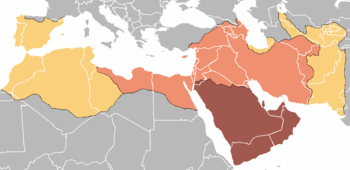
The initial Arab Muslim conquests (632–732), ( Arabic: فتح, Fatah, literally opening,) also referred to as the Islamic conquests or Arab conquests, [1] began after the death of the Islamic prophet Muhammad. He established a new unified political polity in the Arabian peninsula which under the subsequent Rashidun and Umayyad Caliphates saw a century of rapid expansion of Arab power well beyond the Arabian peninsula.
Edward Gibbon writes in History of the Decline and Fall of the Roman Empire:
"Under the last of the Ommiades, the Arabian empire extended two hundred days’ journey from east to west, from the confines of Tartary and India to the shores of the Atlantic Ocean. And if we retrench the sleeve of the robe, as it is styled by their writers, the long and narrow province of march of a caravan. We should vainly seek the indissoluble union and easy obedience that pervaded the government of Augustus and the Antonines; but the progress of Islam diffused over this ample space a general resemblance of manners and opinions. The language and laws of the Qur'an were studied with equal devotion at Samarcand and Seville: the Moor and the Indian embraced as countrymen and brothers in the pilgrimage of Mecca; and the Arabian language was adopted as the popular idiom in all the provinces to the westward of the Tigris."
The Arab conquests brought about the collapse of the Sassanian Empire and a great territorial loss for the Byzantine Empire. Though spectacular, the Arab successes are not hard to understand in hindsight. The Sassanid Persian and Byzantine empires were militarily exhausted from decades of fighting one another. This prevented them from dealing effectively with the mobile Arab raiders operating from the desert. Moreover, many of the peoples living under the rule of these empires, for example Jews and Christians in Persia and Monophysites in Syria, were disloyal and sometimes even welcomed the Arab invaders, largely because of religious conflict in both empires. [2]